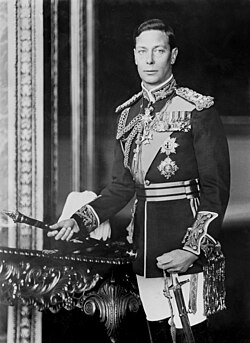Title in the dominions and India
The Dominions were self-governing entities which had the as their respective head of state the same person as was the British sovereign. [12] [13] These Dominions typically used the style and title of the sovereign as proclaimed in the United Kingdom, which, from the reign of Edward VII came to include the phrase, “and of the British Dominions beyond the Seas”, [d] signifying their reign over said Dominions. [15] However, the sovereign reigned in these Dominions in a capacity independent from their position as monarch of the United Kingdom, similar in meaning and usage to, but not the same as modern-day Commonwealth realms, in that they lacked a separate title for each Dominion, until the reign of Elizabeth II. George VI's reign in the Dominions does not completely match his reign in the United Kingdom and his role as monarch in the Irish Free State is debated. [16]
With reference to the British Raj, George VI as sovereign was formally styled His Imperial Majesty the King, Emperor of India, in official Government of India publications. [17] This style, along with the general style of His Majesty the King Emperor, [18] was used until the independence and partition of India in 1947. Per the terms of the Indian Independence Act, the imperial title was to be abolished. However, George VI issued a royal proclamation for that purpose and to that effect only on 22 June 1948, effectively reigning as king in the newly created Dominions of India and Pakistan whilst still bearing the imperial title for himself and his consort. [19]
The title of Kaisar-i-Hind was coined in 1876 by the orientalist G. W. Leitner as the imperial title for the sovereign [20] and was also employed in an official capacity, most notably to denote Crown property in India. [21] This title continues to persist as a placeholder to the modern day in official records dating to the British era, despite the prohibition and deprecation of the use of the said title and all its variants for any and all purposes. [22] Its usage is to be so understood as to denote the Government of India per the relevant provisions of the Government Grants Act, [23] read alongside and in the context of the Transfer of Property Act and the Repealing and Amending (Second) Act. [24] [25]



